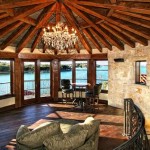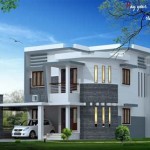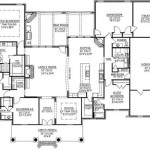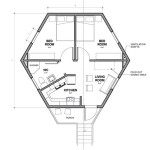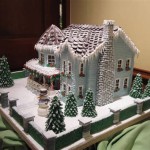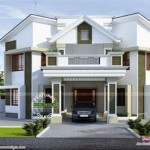```html
Large Lodge Floor Plans: Design and Functionality Considerations
Large lodge floor plans cater to a myriad of needs, serving as impressive family retreats, corporate getaways, or lucrative vacation rentals. Planning such a structure requires meticulous attention to detail, balancing aesthetic appeal with practical functionality. Optimization of space, circulation patterns, and integration with the surrounding environment are crucial aspects that dictate the success of the design.
The sheer scale of a large lodge presents unique challenges and opportunities. Unlike smaller dwellings, efficiently managing large spaces while maintaining a sense of warmth and intimacy demands careful planning. Considerations must extend beyond the individual rooms to encompass the flow between different areas, ensuring a cohesive and comfortable experience for all occupants.
Defining the Purpose and Scope
The first step in designing a large lodge is to clearly define its intended purpose. Is it designed primarily as a private residence for a large family, or will it function as a commercial enterprise catering to guests? Understanding the target user group will heavily influence the layout, amenities, and overall design aesthetic. A family-oriented lodge might prioritize large, open communal spaces, multiple bedrooms, and child-friendly recreational areas. Conversely, a commercial lodge will place emphasis on guest suites, professional kitchens, dining halls, and facilities for hosting events.
The intended occupancy is another critical factor. Determining the maximum number of guests or residents the lodge needs to accommodate will directly impact the size and number of bedrooms, bathrooms, and common areas. Codes and regulations governing occupancy limits can also influence the design, particularly for commercial properties. Furthermore, the anticipated frequency of use should be considered. A lodge intended for year-round occupancy will require different design considerations than one used only seasonally. Factors like insulation, heating and cooling systems, and durable materials become significantly more important for year-round use.
Budgetary constraints also play a significant role in shaping the design. The size and complexity of the lodge directly correlate with construction costs. Establishing a realistic budget early on in the process allows for informed decisions regarding materials, finishes, and architectural features. Value engineering, a process of identifying cost-effective alternatives without compromising quality or functionality, can be employed to optimize the design within the given budget.
Key Considerations for Layout and Spatial Organization
Effective spatial organization is paramount to a successful large lodge floor plan. The layout should prioritize clear and logical circulation patterns, enabling easy movement between different areas of the lodge. Minimizing hallways and maximizing open, interconnected spaces can enhance the sense of spaciousness and promote social interaction.
The arrangement of common areas, such as the living room, dining room, and kitchen, is crucial. These spaces should be strategically located to maximize natural light and offer panoramic views of the surrounding landscape. The kitchen, in particular, should be designed to accommodate the required level of meal preparation, whether it’s a cozy family kitchen or a commercial-grade space capable of catering to large groups. Adequate storage space, efficient appliances, and ample counter space are essential elements.
Privacy is another key consideration, particularly in lodges designed to accommodate multiple families or guest groups. Strategic placement of bedrooms away from common areas can provide a sense of seclusion and minimize noise disturbance. Master suites, often featuring private bathrooms and sitting areas, offer enhanced privacy and comfort. The number of bathrooms should be sufficient to accommodate the anticipated occupancy, preventing overcrowding and ensuring convenience for all users.
Outdoor spaces, such as decks, patios, and balconies, should be seamlessly integrated into the design. These areas provide opportunities for outdoor dining, relaxation, and enjoying the natural surroundings. Orienting outdoor spaces to capture desirable views and maximize sunlight exposure can enhance the overall experience. Consideration should be given to providing shelter from the elements, such as covered porches or retractable awnings, to allow for year-round use.
Incorporating Structural and Mechanical Systems
The structural integrity of a large lodge is paramount, particularly in areas prone to extreme weather conditions. The foundation must be robust enough to support the weight of the structure and withstand potential ground movement. Framing materials should be selected based on their strength, durability, and suitability for the local climate. Engineering calculations should be performed to ensure the structural system meets all applicable building codes and safety standards.
Efficient heating and cooling systems are essential for maintaining a comfortable indoor environment, especially in large, open spaces. Radiant floor heating, forced-air systems, and geothermal heating are among the options to consider, each offering different advantages and disadvantages in terms of energy efficiency, cost, and performance. Proper insulation is crucial for minimizing heat loss in the winter and heat gain in the summer, reducing energy consumption and lowering utility bills. The placement of windows and doors should be carefully considered to maximize natural light while minimizing heat transfer.
Plumbing systems must be designed to accommodate the anticipated water usage. Water pressure should be adequate to serve all fixtures and appliances, particularly during peak demand periods. Hot water heaters should be sized appropriately to meet the needs of all occupants. Low-flow fixtures can help conserve water and reduce water bills. In areas with limited access to municipal water and sewer systems, alternative solutions, such as well water and septic systems, may be necessary. These systems must be designed and installed in compliance with local regulations and environmental standards.
Electrical systems must be designed to meet the energy demands of the lodge, providing adequate power for lighting, appliances, and electronic devices. The electrical panel should have sufficient capacity to handle the anticipated load. Wiring should be installed according to code, with appropriate grounding and surge protection. Energy-efficient lighting options, such as LED bulbs, can help reduce energy consumption. Smart home technology, such as automated lighting controls and thermostat settings, can further enhance energy efficiency and convenience.
Fire safety is a critical consideration. Smoke detectors and carbon monoxide detectors should be installed throughout the lodge, in accordance with local codes. Fire extinguishers should be readily accessible in strategic locations, such as the kitchen and near fireplaces. Fire-resistant materials should be used whenever possible in the construction of the building. Emergency exit routes should be clearly marked and well-lit. Sprinkler systems may be required in certain areas, particularly in commercial lodges. A comprehensive fire safety plan should be developed and communicated to all occupants.
Accessibility is another important consideration, particularly for lodges intended to accommodate guests with disabilities. Ramps, wider doorways, and accessible bathrooms can make the lodge more inclusive and user-friendly. Universal design principles, which aim to create spaces that are usable by people of all abilities, can be incorporated throughout the design. Compliance with the Americans with Disabilities Act (ADA) may be required for commercial lodges.
Finally, the floor plans must comply with all applicable local building codes and regulations. These codes govern various aspects of the design, including structural integrity, fire safety, energy efficiency, and accessibility. Obtaining the necessary permits and approvals from local authorities is essential before construction can begin. Consulting with experienced architects, engineers, and contractors is crucial for ensuring compliance with all applicable codes and regulations.
```
The Big Nelly Large Log Cabin Plan Winterwoods Homes

3 Story 5 Bedroom House Plan With Detatched Garage

The Kokanee Falls Lodge Large Log Cabin Plan Winterwoods Homes

Plan 69407am 5100 Square Foot Craftsman Lodge With Angled Garage And Finished Lower Level Home Design Plans House Kitchen Layout

Open Concept Modern Cabin Floor Plans Houseplans Blog Com

The Kokanee Falls Lodge Large Log Cabin Plan Winterwoods Homes

Pendleton House Plan Most Popular Modern Farmhouse Home Design Main Floor Primary Mf 2639

Big Mountain Lodge Luxury Home First Floor Garrell Associates The Summit At Preston Park Kingsport Tenn

Open Concept Modern Cabin Floor Plans Houseplans Blog Com

The Development Sitemap And Floorplan Mahangate Lodge


